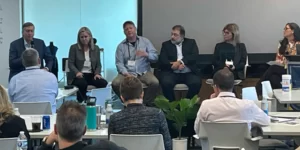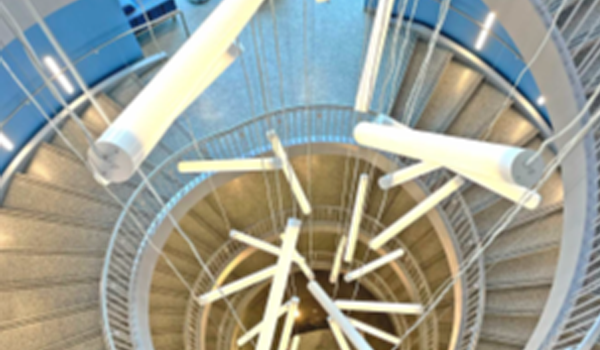Technology Innovation to Drive Growth was the theme of Frost & Sullivan’s first Innovation Workshop & Tour: A Quarterly Series for 2024. The full-day event was sponsored by Frost & Sullivan’s Growth Innovation Leadership Council and took place at Vanderbilt University’s Center for Innovation and Design, The Wond’ry, in Nashville, Tennessee.
Thought leaders from Nokia, Asurion, HP, Vanderbilt University and others shared innovation strategies and insights while collaborating with peers in a truly inspirational setting. The event included a tour of the Wond’ry innovation center, which offers state of the art makerspaces, virtual reality labs, workshops, training opportunities, and programs for entrepreneurs and changemakers. Read on for just some of the ideas and highlights discussed at the event, compiled to help fuel your organization’s strategy and growth in the near and long term.
HOW TO WIN IN THE AGE OF TRANSFORMATIVE TECHNOLOGY
Michel Oostwal, a technology and business leader with over twenty-five years’ experience in global consumer and supply chain innovation, examined how some of the most successful companies develop an effective technology strategy and turn it into a commercial success. As he noted, digital transformation now touches every aspect of business: it brings disruptive technology, it requires deployment of technology strategies at scale and it enables businesses to transform performance. Yet it presents three major challenges:
- Digitally non-native businesses struggle to learn from digitally native businesses
- Enterprises must determine how to create value beyond the tech tools
- Success is largely dependent on partnerships and ecosystems
Digital transformation feels different; it fundamentally shifts the balance between human and machine impact in every aspect of life and business. It requires a new approach to win.
Disruptive technology ventures are often the first step towards transformation. But most fail to reach commercial success at scale. They typically challenge existing technology standards with radically new solutions and carry a high degree of risk.
Multi-functional collaboration is what the best teams do well. Transformation of P&Ls often involves optimizing and sometimes step-changing technology performance. This requires strong executive leadership and an environment where teams are allowed to be innovative and think out of the box without fear of failure or critique. Strong technical leaders act as sponsors. They delegate creativity and exploration to their teams -but own the risk of failure.
GENERATIVE AI: FROM BUZZWORDS TO BRASS TACKS
Jim Cooper, thought leader, inventor, futurist, and technology evangelist for HP, articulated many of the challenges organizations face implementing artificial intelligence in the workplace. He offered guidelines for designing infrastructure and knowledge repositories and discussed key issues and best practices when working with AI.
AI has been adopted faster than the iPhone, but the potential of AI must be managed with caution and guile; addressing its complexities takes skill. Some of the guidelines and use cases shared included:
- Make sure your employees know how prompt engineering, the practice of designing inputs for generative AI tools that will produce optimal outputs, really works
- Trust but verify. Ask: why did AI give that answer? You can say, “tell me how you came to that conclusion”
- You can leverage an AI tool, but you (the human) should ultimately make the decision
- Your employees will have the opportunity to train your models, make sure they are cautious with what they reveal: avoid over-sharing
- Make sure models are developed on a corporate device that you control, otherwise they are exposed
Safeguarding intellectual property and ensuring it is critical, as anything uploaded becomes easily accessible. AI should augment, not replace, human capability. Without a human in the loop, the tool will create plans of action less valuable and at times inferior to what a human can produce. AI’s role is as a tool that enhances human work, not a replacement.
Cohesiveness is the key to AI capability and opportunity. The best practices for AI integration emphasize cohesiveness, which is done through clear communication, precise information-sharing, and robust cybersecurity measures. Finally, remember that innovation with AI should come with ethical and strategic foresight.

BUILD OR BUY? A FRAMEWORK FOR ESTABLISHING AND EXECUTING TECHNOLOGY PARTNERSHIPS
Heath Starr, responsible for R&D, strategic alliances, industry analyst relations and operations policy and processes at SAIC, discussed the dilemma of whether to build in-house, buy existing solutions, or forge partnerships. This is a critical decision that many businesses confront regularly.
Some of the benefits of the three approaches are outlined below:
Build, buy or partner?
- Build – Unique ideas, doing it yourself makes your company stronger, it’s a team building opportunity
- Buy – Additive to your existing investments, already exists in the free market
- Partner – A win-win opportunity, existing customers gain new benefits, and gain access to tangential markets
Starr believes that companies will increasingly favor the “partner” option when deciding whether to build, buy, or partner. Why? Building takes too much time, buying takes too much capital and technology makes partnering easier.
Some of the guidelines and best practices for partnering discussed included:
- When considering a partnership, consider not just your market, your best alternative to a negotiated agreement, or your values; truly envision what a partnership will look and feel like in the future
- Know your guardrails, and what you truly care about early, including IP, exclusivity and go to market motions
- Develop a delegation of authority to ensure rapid decision making and honoring of commitments. Determine who gets what, what your investment committee will look like, and how long you will take to make decisions
Partnerships can be extremely helpful or essential to accelerating business growth, reducing costs, and enhancing products. In the build-buy-partner framework, a nuanced approach considering all possible benefits and detriments should be taken. The transformative potential of partnerships to access new markets and innovate beyond traditional boundaries is enormous, and technology is continuing to make the path to partnership the preferred strategy for innovation.
EVERYTHING YOU’D WANT TO KNOW ABOUT YOUR INNOVATION DNA
Dr. David Owens, Executive Director of the Wond’ry, Vanderbilt University’s Center for Innovation and Design, discussed in detail the major internal and external constraints that are likely to impede the adoption of innovations. He administered a survey to help participants understand the way they approached innovation. The brief assessment helped them to determine whether they were Radical Innovators or Adaptive Innovators. Radical and Adaptive refer to styles of thinking, and making space for both to flourish is important. It is useful to know which type you are, or if you are a mix, and to know your constraints and where you fit in innovation:
- Radical innovation style: Less disciplined, manipulates problem, works in short bursts, takes control, challenges rules, seeks radical change
- Adaptive innovation style: Precision-driven, resolves problems, works steadily, acts accordingly, likes rules, likes status quo
The conflict between the radical and adaptive innovator is that they can clash to the point that they impede innovation. This can be resolved by remembering that each is a style or habit of thinking and space should be made for both. It’s useful to determine what work mode your company is in – is it more Radical or Adaptive overall?
Innovation is about conquering constraints
A key to enabling innovation is to identify and work around typical constraints. Innovation constraints can be internal, external, individual, organizational or even industry wide. Dr. Owens offered strategies to help resolve many of these constraints. To get around individual constraints, gather new data to change perceptions or help team members think in new ways. To combat group constraints, create a space or collaboration zone and processes that support and coordinate innovation. Organizational constraints can be improved by creating strategies that help employees stay intentional about innovation. Design structures that foster information and goal alignment and provide resources to support intrapreneurship within the organization.
To address industry constraints, make sure you understand your pipeline. Know what suppliers you want to work with. Know who you are selling to – does your product align with your customer’s values and wants? By understanding the major innovation constraints and methodically addressing them, enterprises can turn them into stepping-stones and routinize the pursuit of innovation.
These are just some of the insights and implementable tactics shared at Frost & Sullivan’s first Innovation Workshop & Tour: A Quarterly Series for 2024. The Growth Innovation Leadership Council will be hosting their next event at the University of California San Diego Design & Innovation Building on May 14th. Innovating for Sustainability will be the theme. Click here to learn more or register today!



Recent Comments